For the Wildlife Conservation Society’s new CEO, scientific principles and working partnerships are key to conservation.
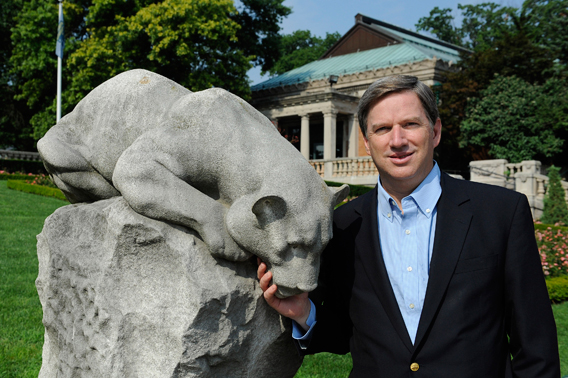
A Man of Science: Dr Cristian Samper, CEO of the WCS.
The Wildlife Conservation Society (WCS) is one of the world’s leading environmental organizations. Founded in 1895 (originally as the New York Zoological Society), the WCS manages 200 million acres of wild places around the globe, with over 500 field conservation projects in 65 countries, and 200 scientists on staff. The WCS also runs five facilities in New York City: the Central Park Zoo, the New York Aquarium, Prospect Park and Queens Zoos, and the world renowned Bronx Zoo.
Building on a long-standing tradition of commitment to environmental science, the WCS recently appointed a top global biologist, Dr. Cristian Samper, as its new President and CEO. Dr. Samper joined the WCS after serving for a decade as the Director of the Smithsonian Institute’s Museum of Natural History.
INTERVIEW WITH CRISTIAN SAMPER
Mongabay: What is your background? What first drew you to the fields of biology and conservation?
Cristian Samper: Since I am from Colombia, raised in the foothills of the Andes, I grew up surrounded by incredible nature. From a very early age, I was very curious about the environment, and it seems most of my childhood was spent collecting and studying the many local plants and animals that shared my part of the world. Naturally (and not surprisingly), I decided to pursue my education in the field of biology. Initially, I attended the University of Los Andes in Bogotá, but eventually came to the U.S. to complete my PhD at Harvard. After finishing my doctorate, I returned to Colombia, where I worked in a ten-year partnership with the Smithsonian to establish Colombia’s National Biodiversity Institute. In an interesting twist, this later resulted in my return to the States to head the Smithsonian’s Museum of Natural History.
Still, it all started with that small boy in the foothills of the Andes. And it really is the curiosity of this small child, who always asked many questions about the natural world, which shaped the direction of my life and career. I guess from the start, I was always meant to be involved in the fields of natural history and conservation.
Mongabay: What prompted your recent move to head the Wildlife Conservation Society or WCS? What do you feel are the strengths of this organization?
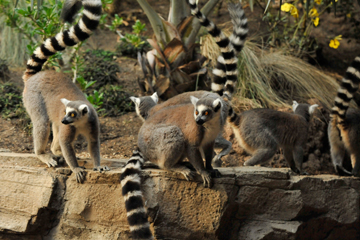 Evolutionary Castaways: Lemurs are an order of primates that survive only on Madagascar. Elsewhere their role in the environment was supplanted by other more advanced primate species, like monkeys. |
Cristian Samper: I’ve always considered the WCS to be one of the great environmental organizations because of its commitment to solid scientific research. The WCS employs scientists all over the world, working directly in the field to further global understanding of biology and nature. It approaches the challenges of conservation starting from the ground up, with scientific methodologies and research as the foundation of all its conservation projects and undertakings.
I had been at the Smithsonian for ten years, which was a truly a rewarding experience since it provided an opportunity to really solidify my working knowledge of the natural world. However, there was one side of me that always wanted to work with conservation directly in the field. The chance to steer the helm of the WCS was the right opportunity for me, at the right time. I am now to hoping to both better understand and document the true mechanics of nature, and also have a meaningful and lasting impact on our world by fostering solid conservation science and management. To meet the challenges of conservation, we need to comprehend fully the true nature of these problems and issues. This is the focus of the WCS, and that’s why I feel so privileged to now be a part of this wonderful organization.
Mongabay: Before transitioning to the WCS, your responsibilities at the Smithsonian included managing the world’s largest collection of natural history specimens. Since this would include access to numerous examples of recently extinct species, what are your views regarding the “global biodiversity extinction crisis” that many scientists feel is currently unfolding?
Cristian Samper: A difficult thing to understand about the concept of extinction is that it is an ongoing function of nature. What few people realize is that most of the species that have evolved on our planet have already disappeared. As some species have gone extinct, new ones have emerged to fill the vacated jobs or ecological niches. However, recent scientific evidence shows that an enlarged and growing human footprint in the world is accelerating the extinction rates of many groups of animals and plants at an unprecedented rate. The process is happening so rapidly that the important environmental jobs or ecological niches these species fulfilled now remain vacant. As more species disappear, the vital roles or jobs they played in their environment ends with them. And these vacancies are undermining the health of the world’s ecosystems on which all life depends, and that includes us. This is a very serious issue that we need to do something about. Yet, we still don’t even have a complete grasp of all the species of plants and animals that make up our world, much less the roles they play within environment or the impact if these species are lost. We need to better understand this process to hopefully manage and correct. Since my view has always been that strong scientific data is needed to make informed decisions and policies, I believe this is the main role for groups like the Smithsonian and the WCS. And though accumulating knowledge is central, immediate actions are also needed. Building on our wealth of science and our direct field presence across the globe, I am hoping the WCS will be in position to balance a measured scientific approach with appropriate steps to meet current conservation challenges.

A Friend of the Tiger: Dr Ullas Karanth of the WCS India.
Mongabay: You’ve been very active in biodiversity conservation in Central and South America. What environmental challenges do these regions face? What other global biodiversity “hotspots” warrant greater attention?
Cristian Samper: Well, it really depends on what part of Latin America we are talking about, as it’s a big place. The drivers of change or damage for most of the Andes region of Colombia happened fifty to a hundred years ago, and the situation there is more or less stabilized. However, in areas like the Amazon Basin, the damage is ongoing and tied to a surge in regional economic activity. New roads and infrastructure are being built across Latin America, accelerating the conversion of rain forests and grasslands into agriculture, with crops often ill-suited to the region. In Brazil’s Mato Grosso region, soy and cattle are quickly turning what had been thriving forests and grasslands into unproductive, ravaged wastelands where cattle, soy, and other agriculture eventually fail to thrive as local environments degenerate without the native species that maintained the health of the region. This same process is happening in our local waters and marine environments where overfishing or the threat of non-native and invasive species (introduced by man) like the Lionfish, are turning what had been thriving fisheries, upon which many people depended, into distant memories. And these memories won’t feed local people and their families
In terms of other parts of the world, there are many areas under similar threats.

Where the Wild Things Are, And Their Champion. Famed conservationist Dr George Scahller of the WCS. The Tibetan Antelope or ‘chiru,’ and the snow leopard of Central Asia; among the many species he’s championed.
For example, I just returned from spending ten days within the Congo rainforest of Central Africa which, on the surface, seems vast and wild. But even there, growing pressures from mining, logging, and agriculture are eroding one of the world’s great rainforest and biodiversity hotspots. While there is legitimate need for many countries to utilize natural resources that are available to them, the key is to develop sustainable practices for the long-term viability of these resources and the continued well-being of their people. The question is: can we find the right balance between conservation and development? I think we can, but it will be a combination of identifying and preserving some of the last great wild areas of our planet and developing sustainable policies that work with, not against, the local environments in which people live and hope to prosper. And in some areas of the world, we may need to actively work to restore what’s been lost. Increasingly that’s a role for the world’s zoos and aquariums, which have emerged as safe houses for many of the planet’s most threatened species. However, it’s not just a matter of saving individual species like a tiger or a polar bear. An awareness of the roles these species and many others play in fostering vibrant and thriving ecosystems, which have broad impact and benefits for both animals and people alike, is essential.
I’d like people to think of the world’s ecosystems and environment as finely tuned machines, honed and crafted by nature over the millennia. Now, if we come in and start haphazardly removing parts from these systems (or “machines”), how can we expect them to function at optimal levels? Let’s build on this line of thought with an analogy to a machine familiar to most people, the automobile. If a person without a sense of automotive mechanics were to start working on your car, randomly removing parts without knowledge of function, would you expect that car to run afterward? That is why the science of conservation is so vital. We need to properly understand the processes of nature to conserve, restore, and maintain the environmental systems on which we all depend.
Mongabay: The WCS is often billed as a benchmark or standard for growing partnerships between zoological facilities and direct field conservation works (in the case of the WCS, the Bronx Zoo and related NYC facilities). How do you feel that modern zoos can better connect the public with frontline conservation?
Cristian Samper: I feel that zoos, aquariums, and facilities like the Smithsonian should offer the public a window into the wide and wonderful natural world that is really our shared heritage. It’s an opportunity for most people who will never have the chance to go to the Congo, or to Himalayas, or the African Savannah’s, etc., to come into contact with wild animals and by extension the entire ecosystems that these species represent. And that connection is so important, especially for people who live in large cities, which are increasingly disconnected from nature. Since we live in a planet that is becoming highly urbanized, I think zoos and aquariums help the public better understand the natural systems that make all life on this planet possible. And what people understand, hopefully, they will appreciate. And what they appreciate, hopefully, they will work to protect.
The ability to connect field conservation work and scientific research directly with the public is one of the main reasons that I was drawn to joining the WCS team. The WCS is one of the world’s oldest environmental organizations, having been in operation for over 117 years. From the very beginning we have had the mandate of running facilities like the Bronx Zoo, while working to launch scientific expeditions around the globe. But we haven’t always linked these two key activities together in eyes of the general public, though building that link is a true and lasting value. But we’re now taking great efforts to connect both of these core activities with the public.
One of my favorite exhibits at the Bronx Zoo is the Congo Gorilla Forest Exhibit. It offers our visitors a feel of the Congo and the area’s biodiversity richness. Through interactive, educational exhibits, it’s a showcase for our field work projects that are working to save this truly magical place. Although I’ve built a career in biology, I had no idea of the unique and rare qualities of this far off place, until I visited a mini-version of this ecosystem that was built by our team, right here in the Bronx! This inspired my recent trip to the Congo and it sharpened my resolve to help both its wildlife and local people.
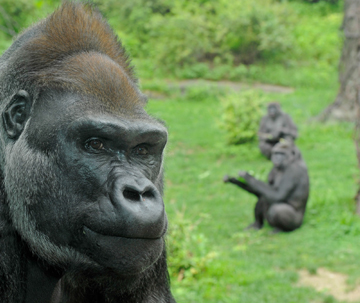 Thriving in a Slice of the Congo Set in the Bronx: Lowland Gorillas of the WCS’s Congo Gorilla Forest. |
Zoos are evolving from menageries that displayed caged wild animals to facilities that are really working to showcase the world’s ecosystems and help the general public understand why these places matter. Whether through our Madagascar exhibit, Congo Gorilla Forest, or our Wild Asia field enclosures, our goal is to show that there is still a world rich in life and it’s a treasure we all share and a resource we all should protect. There is no other zoological organization that has the field presence that we have developed. And few of the other major environmental NGOs have the ability to reach the public like we do, through the zoos and aquariums that we operate in New York City, with four million annual visitors. The WCS has helped raise the bar, but our primary goal isn’t to be the best in a competitive environment with other environmental organizations. We strive to set a very strong example of what we believe is the right way to tackle global environmental challenges. A true position of leadership is having the strength to help others and to lead by example.
Mongabay: Since you are family man (having both a young son and daughter), do you think environmental education for young people is vital? How do you feel it’s best to engage young people regarding the environment?
Cristian Samper: Public education is really essential when it comes to environmental issues, and children respond very well in this area. Young children seem to have this very natural interest in plants and animals. If you ever watch a small child with something as simple as a butterfly, you’ll see this sense of curiosity and wonder. With the numerous distractions of the modern world, many people lose sight of their connection with nature, and I believe that this is accelerating an increasingly urban world. When the public is disconnected from nature they can make decisions and support policies that work against the health of the global environment (which is really acting against their own real interests). So, how do you genuinely engage young people or anyone really, to consider the environment? You offer them the opportunity to experience a little bit of nature, firsthand. I believe this is one of the most important roles of a modern zoo: the opportunity to offer the public a small, but tangible window into the beauty of the natural world. I feel that we need this sense of appreciation and connection more than ever.
Mongabay: In closing, what are your overall goals for the WCS, going forward?
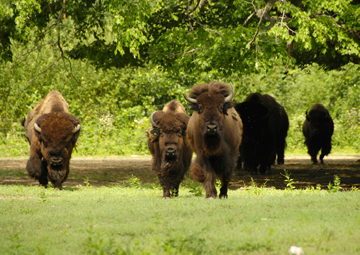 ‘No Home on the Range?’ Facing extinction at the end of the 19th Century, the American Bison was saved due in large part to the early efforts of the Wildlife Conservation Society. |
Cristian Samper: Here at the WCS, we plan to continue building on the great traditions of this 117-year old institution. I’d like to hang onto our strengths as a leading institution in the field of environmental science, while continuing to improve and support public outreach and educational opportunities like those offered by the facilities we operate in New York City. But most importantly, I would like to see us greatly increase the impact and scale of our efforts globally. I’ve been asking my team, “How can we have ten times the impact that we have now?” In the field of conservation we may be winning a few battles, but right now, we are losing the overall war. To change course, we need to expand our horizons by working in partnerships with other organizations, including other zoos, environmental NGOs, governmental groups, and the private sector. And we need to bring this message to a much larger audience, through partnerships with media groups, like Mongabay. To truly safeguard our environment we need to reach more than the 4 million visitors who come to our New York facilities, more than a television audience of a 40 million, or even more than all the people in this country. We need to reach, in some form, the billions of people who share this world. To accomplish this imposing goal, we all need to work together. I believe there is a natural eloquence to this solution, for the story of the natural world is really one of connections. My goal is that WCS will continue to build the bridges and uncover the connections that tie us all, and offer the insights and resolve to help the world’s inhabitants step up together and finally and truly do something about the environmental challenges we all face.
Related articles
Seeing the forest through the elephants: slaughtered elephants taking rainforest trees with them

(03/11/2013) Elephants are vanishing. The booming illegal ivory trade is decimating the world’s largest land animal, but no place has been harder hit than the Congo basin and its forest elephants (Loxodonta cyclotis). The numbers are staggering: a single park in Gabon, Minkebe National Park, has seen 11,100 forest elephants killed in the last eight years; Okapi Faunal Reserve in the Democratic Republic of the Congo has lost 75 percent of its elephants in fifteen years; and a new study in PLoS ONE estimates that in total 60 percent of the world’s forest elephants have been killed in the last decade alone. But what does that mean for the Congo forest?
Captive frogs may be spreading diseases to wild cousins across Southeast Asia
(03/07/2013) Scientists have documented a series of links between exotic frogs for trade and diseases in wild frogs in Southeast Asia, including the first documented case of the chytrid fungus—a virulent and lethal disease—in Singapore. According to researchers writing in a new study in EcoHealth, frogs imported into Southeast Asia as pets, food, or traditional medicine are very likely spreading diseases to wild populations.
What happened to the elephants of Bouba Ndjida? [warning: graphic photos]
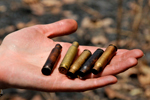
(03/07/2013) A new report released by the Wildlife Conservation Society says that poachers have killed a staggering 62 percent of Africa’s forest elephants in the last decade. The insatiable demand for elephant ivory hails mainly from China and Thailand, which is ironically hosting this year’s CITES (CoP16) meeting. The meeting will continue until March 13 2013. The study is based on a survey of five elephant range states including Cameroon. Cameroon is the home of Bouba Ndjida National Park, where the dizzying massacre of 650 elephants occurred last year.
The end of wild Africa?: lions may need fences to survive
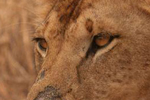
(03/06/2013) In order for dwindling lion populations to survive in Africa, large-scale fencing projects may be required according to new research in Ecology Letters. Recent estimates have put lion populations down to 15,000-35,000, a massive drop from a population that was thought to be around 100,000 in 1960. The worsening plight of lions have pushed the researchers to suggest what is likely to be a controversial proposal: fence the top predators in.
Warnings of global ecological tipping points may be overstated

(03/05/2013) There’s little evidence that the Earth is nearing a global ecological tipping point, according to a new Trends in Ecology and Evolution paper that is bound to be controversial. The authors argue that despite numerous warnings that the Earth is headed toward an ecological tipping point due to environmental stressors, such as habitat loss or climate change, it’s unlikely this will occur anytime soon—at least not on land. The paper comes with a number of caveats, including that a global tipping point could occur in marine ecosystems due to ocean acidification from burning fossil fuels. In addition, regional tipping points, such as the Arctic ice melt or the Amazon rainforest drying out, are still of great concern.
A promising initiative to address deforestation in Brazil at the local level

(03/05/2013) The history of the Brazilian Amazon has long been marked by deforestation and degradation. Until recently the situation has been considered out of control. Then, in 2004, the Brazilian government launched an ambitious program to combat deforestation. Public pressure—both national and international—was one of the reasons that motivated the government to act. Another reason was that in 2004, deforestation contributed to more than 55 percent of Brazil’s total greenhouse gas emissions, making Brazil the fourth-largest greenhouse gas emitter in the world.
Extinction warning: racing to save the little dodo from its cousin’s fate

(03/04/2013) Sometime in the late 1600s the world’s last dodo perished on the island of Mauritius. No one knows how it spent its final moments—rather in the grip of some invasive predator or simply fading away from loneliness—but with its passing came an icon of extinction, that final breath passed by the last of its kind. The dodo, a giant flightless pigeon, was a marvel of the animal world: now another island ground pigeon, known as the little dodo, is facing its namesake’s fate. Found only in Samoa, composed of ten islands, the bird has many names: the tooth-billed pigeon, the Manumea (local name), and Didunculus (“little dodo”) strigirostris, which lead one scientist to Christen it the Dodlet. But according to recent surveys without rapid action the Dodlet may soon be as extinct as the dodo.
Bolivia leads the way in wetland protection

(03/04/2013) Bolivia continues to be a champion for Amazonian conservation. On February 2, 2013, Bolivia celebrated World Wetlands Day with the designation of more than 6.9 million hectares of the Llanos de Moxos to the Ramsar Convention’s Wetlands of International Importance. In addition to being the largest Ramsar designation to date, Bolivia now claims 14.8 million hectares of protected wetland, making it the leading Contracting Party out of 164 participating countries in terms of Ramsar site surface area.